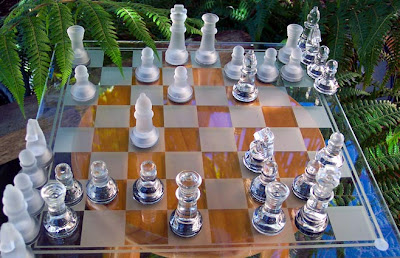 Joost van Steenis, Mathematical Chip:
Joost van Steenis, Mathematical Chip:In Japan they use a kind of fuzzy logic based on discrete numbers. Washing machines determine with sensors a value that tells something about the amount of dirt. The weight is also measured and a third sensor looks at the colours. Then an algorithm determines how much water and washing powder is needed and what the temperature of the water has to be. These variables are independent from each other and they can be quantified. So you get a washing machine with thousands of programs. This pseudo fuzzy logic is also used in lifts, which on their own accord travel to those floors where most people are waiting. And in cameras to compensate for tremors in the human hand. But this is not real fuzzy logic. The fuzzy situation is split up into very small steps after which discrete values are allotted to the parts. These values can be used in calculations according to the Boolean logic. Boolean logic is by the way a special part of fuzzy logic. It looks fuzzy but it is still discrete. This soft Japanese computing is still computing. Vague concepts are being converted into numbers that can be used in a computer. But our brain works with real fuzzy computing.Earlier I wondered if it would be possible to bring order and system to fuzzy interactions between fuzzy parts of a proof process. The following comment by Mr. Steenis (id.) sounds both reassuring and discouraging:
So you start with a fuzzy input that leads via fuzzy dependency, fuzzy thinking, fuzzy judgement and fuzzy logic to a fuzzy output. On the basis of a fuzzy complex the brain decides which piece or pawn has to move. And the brain includes in its judgement also fuzzy ideas about such fuzzy facts as the aggressiveness of the opponent. The discrete position on the board gives rise to a fuzzy process that results in a discrete decision: only one move can be executed on the board. For this kind of fuzzy process techniques we do not have any theory. We do not know how we can obtain a fuzzy output from a fuzzy input.Is Mr. Steenis correct?
Mr. Steenis shortly grows (pleasingly) philosophical (and whimsical):
When problems get complicated thinking becomes even more difficult and it is even more important to change the way of thinking. It is striking that in conversations most people understand fuzzy concepts fairly well. Words as about, maybe, long, short, nice and agreeable are all fuzzy. In a conversation these words are never described exactly. Even the question what is life is fuzzy. Viruses grow but they can not reproduce. Are they alive? People are alive but when does human life begins? With the first two cells from which later a human will grow? Or is it needed that there are 4, 8, 16, 32, 64, 1024, 8192 or even still more cells before we can call a living entity human? The whole abortion discussion turns around such fuzzy concepts. Fuzzy exists, the consequences are everywhere and it is strange that scientists mostly avoid this reality. In some simple cases they use fuzziness but when problems get more complex fuzzy disappears and all is expressed in absolute values. But in complicated problems precise descriptions become meaningless and meaningful descriptions are not precise. Let humans become a little more chaotic.



